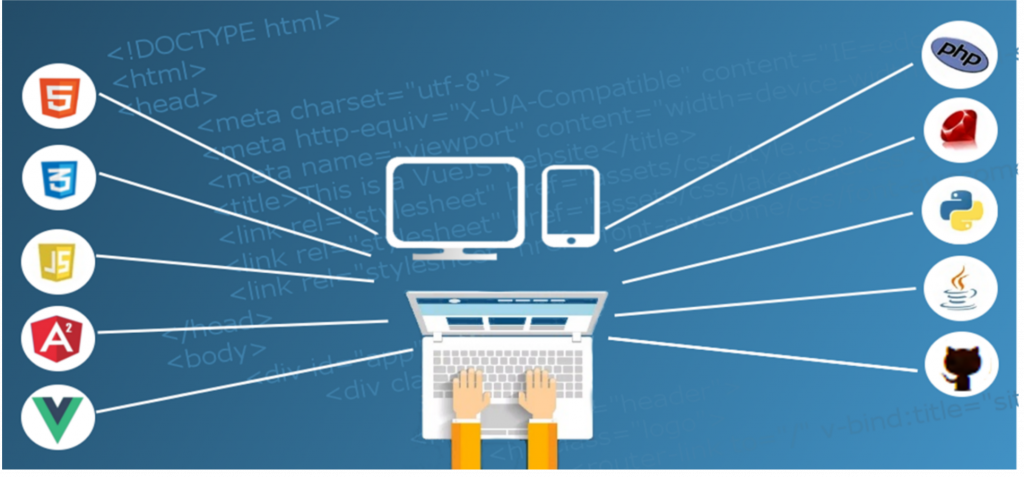Are you thinking of switching careers or considering learning new skills to improve your existing career? Then technical skills are critical. Not only do they help you land jobs that pay more, but they also allow for more flexible schedules and creative workloads. However, finding a job in the tech industry isn’t all fun and games; you need to cut through lots of jargon and hone your frontend web development skills. Knowing what it takes to develop mind-blowing user experiences gives you better insight into your strengths as well as the areas you’re still lacking in. Find out what core coding skills are necessary to land your first web development job.
Know the basics

But first things first – every frontend developer must inculcate three key coding skills.
- HTML
- CSS
- JavaScript
These constitute the basic building blocks of web development, and you cannot make much headway in your career if gaps are present in your knowledge. Fortunately, plenty of affordable or free learning platforms on the Internet allow you to develop these coding skills.
HTML
HTML, the abbreviation for HyperText Markup Language, is the fundamental structural component of every Internet site. The markup language helps you make notes in digital documents that can be differentiated from regular text. Basically, web pages are unable to exist without HTML.
CSS
Cascading Style Sheets or CSS is the language for presenting the created document using HTML. CSS works in conjunction with HTML to add style to your pages. Think of it this way — HTML comes first and establishes the foundation for your page, and then CSS is used to form the page’s color, fonts, layouts, and overall style.
Even though CSS is not an absolute necessity to get a site up and running, almost every website on the Internet makes use of some form of styling to catch the eye of visitors.
The latest versions of CSS allow you to input animations and other advanced elements that were possible using just Flash or JavaScript in the past. Combined together, HTML and CSS languages are indispensable to becoming an accomplished front end developer.
JavaScript

CSS and HTML differ from this tool in one major aspect — while the former is a style sheet language and the latter is a markup language, JS is a full-fledged programming language. While CSS and HTML impact the presentation of a web page, this sets the function.
JS or JavaScript has witnessed tremendous advances in the past few years. Nowadays, the language serves numerous purposes and is versatile enough to be used on either the back or front end. When it comes to frontend development, JavaScript is necessary for creating interactive web pages.
It allows web designers to create awesome content, including quizzes, polls, or submission forms. Several JS libraries have popped up online in recent times that allow you to enhance your web pages.
But if you’re preparing to launch a career as a frontend developer, simply knowing basic JavaScript won’t do; you must also familiarize yourself with JQuery, the most well-known of the JavaScript libraries.
What is jQuery?
jQuery is a collection of extensions and plugins that simplify and speed up JS usage on your website. You will find jQuery extremely useful if you’re dealing with common tasks that take up a large chunk of your time.
What jQuery does is take a task relying on several lines of JS code and compress them into a format capable of being executed in just one line. This makes it easier to code with JS.
MV JS Frameworks
JavaScript frameworks are useful for condensing and organizing your code. For MV or MVC options, you have a selection of 30 frameworks, the two most popular being angular.js and backbone.js. Now, learning the JavaScript framework is one of the most difficult aspects of becoming an actual frontend developer, but it is well worth the time and effort if you wish to develop your coding skills to the fullest.
CSS tools
You can get used to CSS tools easily compared to JS frameworks mentioned above. Look for the following categories of tools:
- CSS frameworks: These frameworks can be used to optimize the workflow using built-in grids along with other kinds of CSS frameworks. Two of the most used examples include Foundation and Bootstrap.
- Precompilers: Also known as a preprocessor, a precompiler provides numerous benefits to the designer, from maintaining the overall organization to ridding the code of all extraneous elements. This is one of the simplest ways to write CSS while promoting principles associated with Don’t Repeat Yourself (DRY). Some of the most used precompilers for CSS include Less, Stylus, and Sass. However, if you’re a fresher and are just learning the ropes, it is better to stick to a single tool and master it.
- Responsive design: Nowadays, many advanced devices are available, which means your site needs to adapt to each of them. Thanks to responsive design, you are able to create sites that work across various display sizes, whether it be a smartphone or tablet or desktop. Some frameworks, such as Foundation and Bootstrap, come with the built-in responsive design. So, when you pick up one of these, you are good to go.
Version Control/GIT

Suppose you are hard at work, styling with CSS, programming using JS, or marking up with HTML. You are expected to conduct several revisions during the development stages. If something goes awry along the way, you will have to scrap the whole thing and redo it from the beginning. However, that is extremely strenuous and time-consuming.
But with version control, you are in charge of controlling and tracking the changes made to your source code, which means you can avoid all the hassle. Version control software includes the likes of open source pioneer Git, and it can help you track changes, thereby allowing you to go back to past versions and locate the mistake without redoing the whole thing from scratch.
Get coding skills and control your destiny
Although these coding skills might seem hard at the start, once you get the hang of it, you will find it easier and easier to work with them over time. However, if you want to stick to the basics, like JS, CSS, and HTML, those skills are enough to make you qualified frontend designers.
Featured image: Pixabay



